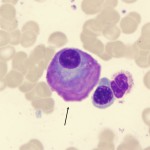Would you want to know if your myeloma was likely to result in early vs late mortality? I would like to know. What’s your feeling about this?

Gene Variants Can Predict Early or Late Mortality in Multiple Myeloma
Elsevier Global Medical News. 2008 Nov 11, MG Sullivan
Genetic variants in the DNA of patients with multiple myeloma appear to strongly influence survival, a groundbreaking new genomic study has concluded.
In this first pass at identifying genetic markers for survival, treatment response, and complications in the disease, a group of 3,400 variants predicted early or late mortality 76% of the time, Dr. Brian Van Ness said in an interview about the initial report (BMC Medicine 2008 Sept. 8 [doi: 10.1186/1741-7015-6-26]).
“Clearly, inherited genetics influenced survival,” said Dr. Van Ness
of the University of Minnesota, Minneapolis. “What we have not yet done is identify which specific variants are responsible for these differences. Our hypothesis is that it won’t be a single variant driving response or survival, but a complex interaction of many.”
After narrowing down the initial 3,404 candidate single nucleotide polymorphisms (SNPs), Dr. Van Ness and his colleagues are now focusing on 1,000 SNPs found to be most strongly associated with the outcome
measures. More studies are on the way using this genetic panel, he said.
Indeed, just 2 weeks after the first study appeared, a coinvestigator, Dr. Gareth Morgan of London’s Royal Marsden Hospital, published findings on the association between certain SNPs and the incidence of
treatment-associated venous thromboembolism (VTE). The analysis showed that some of the variants associated with thalidomide-related VTE occurred in pathways important in drug transport and metabolism.
“The effects of the SNPs associated with thalidomide-related VTE may be functional at the level of the tumor cell, the tumor-related microenvironment, and the endothelium,” Dr. Morgan and his colleagues wrote (Blood 2008 Sept. 19 [Epub ahead of print]).
“Another study, currently submitted, has identified an association between some of the variants and the development of severe myeloma bone disease,” Dr. Van Ness said.
The initial investigation used a genetic screen developed from two DNA data sets: cells from the Coriell Institute for Medical Research, and samples obtained from multiple myeloma patients enrolled in two
randomized drug trials, as well as some unaffected spouses. The samples came from white, black, Hispanic, and Asian patients from North America and Europe. The candidate SNPs, occurring on 983 genes, were chosen based on the most recent genetic research and included on a myeloma-specific gene-testing chip.
The investigators chose extremes of survival as the first test of the panel, because this comparison was most likely to show the effects of any genetic variant. “We took the worst outcomes – people who died in
the first year of their disease – and the best outcomes – those who survived at least 3 years without progression,” Dr. Van Ness said. After repeatedly running the screen on both data sets, the team concluded that, as a whole, it discriminated the survival groups correctly 76% of the time.
Further drilling down identified several SNPs of particular interest, including some associated with drug metabolism, transport, and export; a variant that induces myeloma apoptosis; one associated with cellular
migration and angiogenesis; and several linked to proliferative responses.
Although not designed to detect racial differences, the initial screen did identify some interesting variations: 401 of the SNP variants occurred only in black patients. In whites, there was no difference in these SNPs between cases and controls.
“We know that African Americans have a two- to threefold increase in the incidence of myeloma, but we don’t yet know why,” Dr. Van Ness said. “We’ll be trying to identify those genetic variants that might uniquely increase the risk for one race to develop myeloma over another.”
Neither this initial analysis nor subsequent ones will examine the possible interplay of environment with genetics. But, Dr. Van Ness said, such studies may be forthcoming. The International Myeloma Foundation of North Hollywood, Calif., is conducting a patient survey to begin assessing what role – if any – environmental exposure plays in disease development. The 36-page survey asks patients to detail their environmental, dietary, and geographical exposures. The National Cancer Institute will collaborate with the group in evaluating the data.
The International Myeloma Foundation is also the curator of the DNA samples used in the analysis through its Bank on a Cure program. “Bank on a Cure was developed by an international group of physicians and scientists to deal with a disease that’s difficult to deal with,” Dr. Van Ness said. “It’s not a high-incidence cancer, so it’s not easy to research.”
The Bank on a Cure group developed cooperative agreements with national and international clinical trial groups, and the studies were funded by the International Myeloma Foundation. While exploration of genetic variants relevant to multiple myeloma is in its infancy, Dr. Van Ness predicted the effect could be profound.
“It’s already fairly well established that the genetics of the tumor cells themselves impact response and survival,” he said. “But beyond this is the impact of every individual patient’s genetics – how they absorb, distribute, metabolize, and export drugs, even what race they are. If we understand why someone doesn’t respond to a drug, we could better target their therapy. If we could predict which patient might develop a life-threatening blood clot during treatment, we could take steps to prevent it.”
Copyright © 2008 International Medical News Group
Source: http://www.oncologystat.com/news-and-viewpoints/news/Gene_Variants_Can_Predict_Early_or_Late_Mortality_in_Multiple_Myeloma_US.html